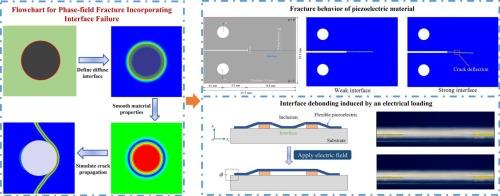考虑界面破坏的柔性压电复合材料相场建模
IF 5.3
2区 工程技术
Q1 MECHANICS
引用次数: 0
摘要
在有限变形框架下,基于相场内聚区模型(PF-CZM),建立了考虑整体断裂和界面破坏的柔性压电复合材料统一建模方法。与先前主要研究小变形下脆性复合材料的研究不同,这项工作侧重于具有明显几何和材料非线性的可拉伸柔性压电材料,这导致了强耦合的控制方程和增加的计算复杂性。引入界面相场参数描述扩散界面,引入裂纹相场参数控制裂纹扩展。该模型考虑了多种内聚软化规律来模拟界面破坏,并捕捉了界面强度对整体断裂性能的影响。数值框架在ABAQUS中实现,HETVAL子程序用于扩散界面建模,UEL用于裂缝模拟。当损伤主要局限于矩阵内部时,忽略界面效应可以显著降低计算成本,同时不影响精度。在涉及界面破坏的情况下,该模型有效地研究了界面强度在裂纹扩展和断裂特征中的作用。数值结果表明界面强度、外加电场和夹杂物尺寸对断裂行为的影响。界面强度越高,峰值承载能力和抗破坏能力越强,界面强度越弱有利于界面开裂,界面强度越强有利于基体开裂。此外,当柔性压电材料与软基结合时,外加电场可能引发界面脱粘,这一现象得到了数值模拟和实验观察的支持。本文章由计算机程序翻译,如有差异,请以英文原文为准。

Phase-field modeling of flexible piezoelectric composites incorporating interfacial failure
Within the finite-deformation framework, a unified modeling approach is developed for flexible piezoelectric composites based on the phase-field cohesive zone model (PF-CZM), accounting for both bulk fracture and interfacial failure. Unlike previous studies that primarily address brittle composites under small deformations, this work focuses on stretchable flexible piezoelectric materials exhibiting pronounced geometric and material nonlinearities, which lead to strongly coupled governing equations and increased computational complexity. An interface phase-field parameter is introduced to describe diffuse interfaces, while a crack phase-field parameter governs crack propagation. The model accommodates various cohesive softening laws to simulate interfacial failure and captures the influence of interface strength on overall fracture performance. The numerical framework is implemented in ABAQUS, with a HETVAL subroutine used for the diffuse interface modeling and UEL for fracture simulations. When damage is primarily localized within the matrix, neglecting the interface effects significantly reduces computational cost without compromising accuracy. In cases involving interfacial failure, the model effectively investigates the role of interface strength in crack propagation and fracture characteristics. Numerical results demonstrate the effects of interface strength, applied electric fields, and inclusion size on fracture behavior. Higher interface strength enhances peak load capacity and resistance to failure, with weaker interfaces favoring interfacial cracking and stronger interfaces promoting matrix cracking. Furthermore, in flexible piezoelectric materials bonded to soft substrates, interfacial debonding may be triggered by applied electric fields, a phenomenon supported by both numerical simulation and experimental observation.
求助全文
通过发布文献求助,成功后即可免费获取论文全文。
去求助
来源期刊
CiteScore
8.70
自引率
13.00%
发文量
606
审稿时长
74 days
期刊介绍:
EFM covers a broad range of topics in fracture mechanics to be of interest and use to both researchers and practitioners. Contributions are welcome which address the fracture behavior of conventional engineering material systems as well as newly emerging material systems. Contributions on developments in the areas of mechanics and materials science strongly related to fracture mechanics are also welcome. Papers on fatigue are welcome if they treat the fatigue process using the methods of fracture mechanics.

 求助内容:
求助内容: 应助结果提醒方式:
应助结果提醒方式:


